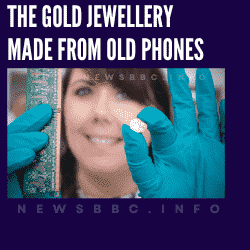Introduction:
The exponential growth of electronic waste (e-waste) has become a gold jewellery, with discarded laptops and mobile phones contributing significantly to this mounting problem. To address this issue and reduce the dependence on finite raw materials, the UK Royal Mint has embarked on a groundbreaking journey to extract precious metals hidden within electronic devices. This innovative process holds the promise of sustainability and reduced environmental impact, marking a significant step towards responsible resource management.
A Glimpse Behind the Scenes of gold jewellery
Nestled near Cardiff, South Wales, the Royal Mint is a globally renowned institution responsible for producing billions of coins for over 30 nations. However, behind the scenes, this institution has been diligently working on a secret project for the past two years – a project aimed at revolutionizing the recovery of metals from electronic waste.
1.1. The Mystery Unveiled:
In a secure laboratory setting, chemist Hayley Messenger, an expert in sustainable precious metals, offers a glimpse into the Royal Mint’s groundbreaking initiative. With the aura of secrecy surrounding the project, she pours a “magic green solution” onto fragmented circuit boards contained within a one-liter glass flask.
1.2. The Innovators:
Collaborating with a team of chemists, chemical analysts, and Canadian start-up Excir, the Royal Mint has developed and patented an energy-efficient method to extract an impressive 99% of gold from discarded laptops and old mobile phones. This achievement is a testament to the dedication and innovation driving this endeavor.
The Gold Extraction Process
The Royal Mint’s gold extraction process is a testament to ingenuity and sustainability, offering a glimpse into the future of responsible resource management.
2.1. Room Temperature Alchemy:
In just four minutes, the magic green solution dissolves and leaches out the gold from the circuit boards. What is remarkable is that this entire process occurs at room temperature, with incredible efficiency.
2.2. Reusable Solution:
The chemical solution used in the extraction process can be reused up to 20 times, with the concentration of dissolved gold increasing with each cycle.
2.3. Solidifying Gold:
Another proprietary solution is introduced, transforming the dissolved gold into solid metal once again. The resulting gold powder is filtered out and then melted down in a furnace, creating thumbnail-sized gold nuggets.
Sustainable Scalability of gold jewellery
One of the remarkable features of the Royal Mint’s approach is its potential for scalability and sustainability.
3.1. Craftsmanship:
The extracted gold nuggets can be transformed into exquisite jewellery items such as pendant necklaces, earrings, and cufflinks. This process offers a sustainable source of precious metals for the jewellery industry.
3.2. Expanding the Reach:
While the Royal Mint’s current focus is on gold recycling, the ambition is to recover other precious metals from the same circuit board raw material. This expansion holds the promise of further reducing the environmental impact of e-waste recycling.
3.3. Localized Recycling:
The Royal Mint’s commitment to localized recycling has the potential to significantly reduce waste miles, as e-waste no longer needs to be transported across seas and borders. This approach aligns with sustainability and environmental responsibility.
Also see:Airlines Issue Warnings as UK Faces Flight Delays due to Air Traffic Control Fault
The Growing E-Waste Challenge
E-waste, recognized as the fastest-growing waste stream globally, poses a mounting challenge that demands innovative solutions.
4.1. E-Waste Epidemic:
According to the United Nations Environment Programme, an estimated 50 million tonnes of e-waste is generated worldwide annually, surpassing the weight of all commercial airliners ever produced. Shockingly, only 20% of this e-waste is formally recycled.
4.2. A Global Concern:
The United Kingdom ranks among the top producers of e-waste per capita, emphasizing the urgency of addressing this issue. The World Economic Forum predicts that annual e-waste production could more than double to 120 million tonnes by 2050.
4.3. Gold’s Hidden Potential:
Gold, a finite resource, lies within disused electronics, constituting 7% of the world’s gold reserves. Traditional gold extraction processes often involve carbon-intensive and crude smelting practices, underscoring the need for sustainable alternatives.
Responsible Recycling at Home gold jewellery
The Royal Mint’s commitment to sustainable e-waste recycling echoes the growing sentiment that the responsibility for waste management should be localized.
5.1. Environmental Responsibility:
Mark Loveridge, the commercial director at the Royal Mint, emphasizes the importance of managing e-waste locally. Developing e-waste supply chains centered around recycling plants reduces the environmental impact associated with shipping waste abroad.
5.2. The Circular Economy:
The Royal Mint’s innovative approach seeks to minimize waste and maximize resource utilization. It ensures that every part of discarded circuit boards finds a meaningful use, contributing to a circular economy.
5.3. Global Collaboration:
The Royal Mint’s ambition extends beyond the UK, as it seeks global partners to adopt this innovative technology. This collaborative effort can catalyze a worldwide shift towards responsible e-waste management.
A Sustainable Future of gold jewellery
As we look to the future, the Royal Mint’s pioneering work offers hope for a more sustainable and responsible approach to e-waste management.
6.1. Exploring Beyond Gold:
The potential to recover additional precious metals, such as palladium, silver, and copper, from e-waste opens doors to diverse applications beyond jewellery. These metals could support the production of electric vehicles and renewable energy systems.
6.2. A Zero-Waste Vision:
The Royal Mint’s vision for zero waste exemplifies its commitment to environmental responsibility. Every part of the e-waste supply chain is optimized for reuse and recycling.
6.3. Spreading the Vision:
The challenge ahead lies in encouraging and incentivizing the reuse of e-waste close to home. By prioritizing and supporting local recycling initiatives, we can make responsible recycling the norm.
Conclusion:
The Royal Mint’s remarkable journey into e-waste recycling presents a beacon of hope for a world grappling with the growing menace of electronic waste. Their innovative approach not only offers a sustainable solution for recovering precious metals but also emphasizes the importance of localized recycling efforts. As we confront the challenges of a rapidly evolving digital age, responsible e-waste management is not just a choice; it’s an imperative for safeguarding our planet’s resources and ensuring a sustainable future.
Also visit:Joe Biden pens touching tribute to Jimmy Buffett ‘A poet of paradise’

